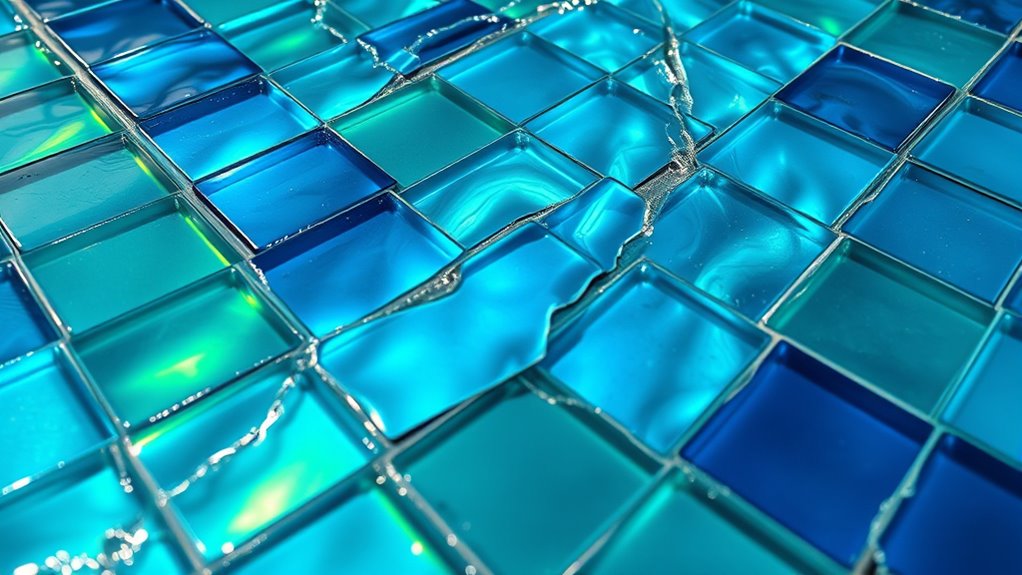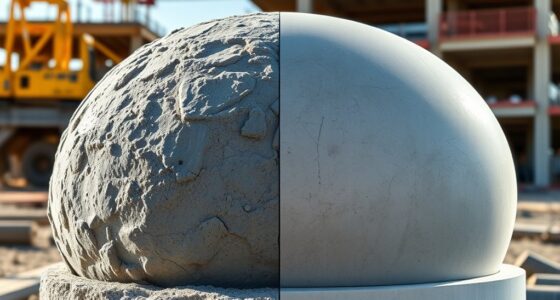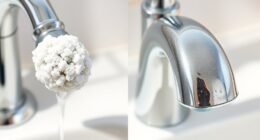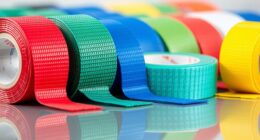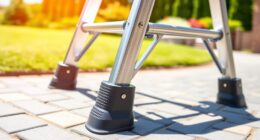To guarantee your glass tile spillway is durable, choose a high-quality, epoxy grout that resists stains, water, and freeze-thaw cycles. Always include flexible expansion joints spaced every 10-15 feet and seal these with waterproof sealants to allow for movement. Proper surface prep and installation are vital, and routine inspections help catch issues early. Staying updated on best practices ensures your spillway remains both functional and beautiful over time.
Key Takeaways
- Use high-quality, epoxy or frost-resistant grout designed for glass tiles and outdoor conditions.
- Incorporate expansion joints every 10-15 feet and seal them with flexible, waterproof sealants.
- Select freeze-thaw rated grout and sealants to prevent water infiltration and damage from temperature changes.
- Ensure proper substrate preparation, clean installation, and adequate curing for long-term durability.
- Regularly inspect and maintain grout joints and tiles to address cracks, movement, or damage early.
Selecting the Ideal Grout for Glass Tile Spillways
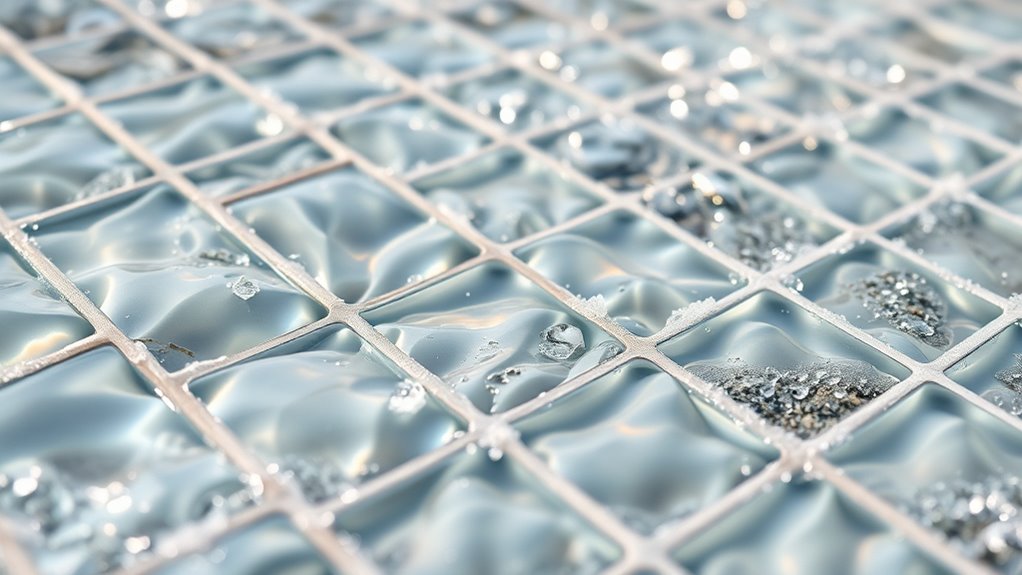
Choosing the right grout for your glass tile spillway is crucial to guarantee durability and an attractive finish. You should opt for a high-quality, non-porous grout specifically designed for glass tiles. Epoxy grout is an excellent choice because it resists stains, water, and chemicals, making it ideal for outdoor spillways exposed to constant moisture. Cement-based grouts can work if they are non-sanded and properly sealed, but they’re more prone to staining and cracking over time. Color-matched or translucent grout options can enhance the look of your spillway by blending seamlessly with the tiles. Always ensure the grout you choose is compatible with glass and suitable for outdoor or wet environments. Proper selection now prevents future repairs, ensuring your spillway remains attractive and functional for years. Using the right grout selection is essential to accommodate movement and prevent cracking in outdoor installations.
Accommodating Movement and Expansion Joints
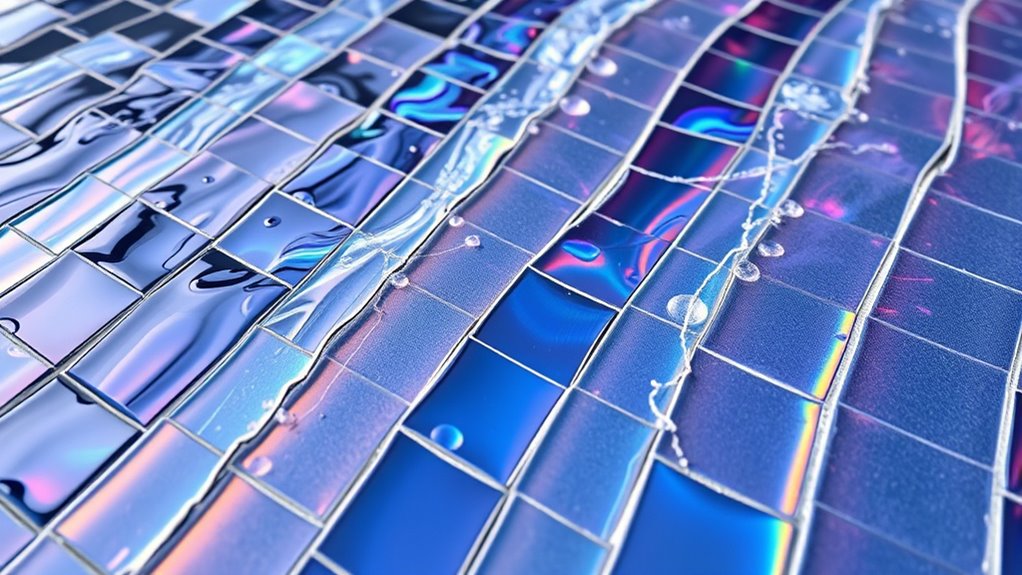
Since grout alone can’t absorb the natural movement of your spillway, incorporating proper expansion joints is essential. These joints allow for movement caused by temperature fluctuations and structural shifts, preventing cracks and tile damage. Proper placement and sizing are critical; they should be spaced based on the spillway’s size and expected movement. Use flexible sealants within these joints to accommodate movement without compromising waterproofing. Consider the following table for guidance:
| Joint Type | Placement |
|---|---|
| Expansion Joints | Every 10-15 feet along spillway |
| Contraction Joints | At changes in direction or load |
| Material | Characteristics |
| Rubber or PVC | Flexibility and durability |
| Silicone Sealant | Waterproofing and movement absorption |
Additionally, selecting the right electric bike conversion kit can enhance your riding experience, especially for tasks like inspecting or maintaining spillways.
Ensuring Freeze-Thaw Resistance in Spillway Environments
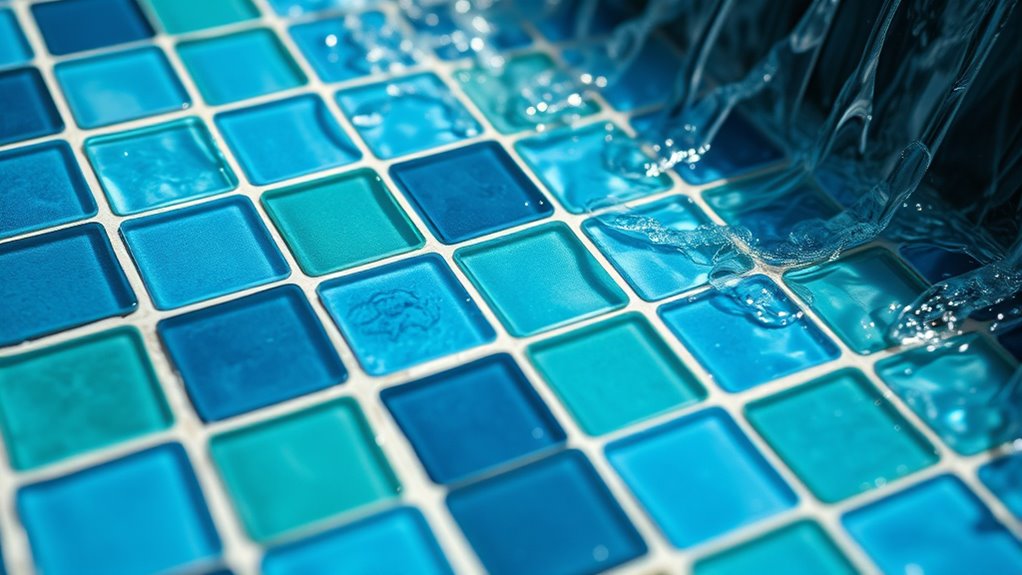
To guarantee your spillway’s glass tile installation withstands freeze-thaw cycles, it’s essential to select materials and installation methods designed for durability in cold environments. Use high-quality, frost-resistant grout and adhesives formulated for freeze-thaw conditions. Make certain the tiles are properly sealed with a waterproof coating that prevents water infiltration, which is imperative since trapped moisture can expand during freezing, causing damage. Incorporate a flexible grout and appropriate movement joints to accommodate expansion and contraction. Proper surface preparation, including removing any moisture or debris before installation, is critical. Additionally, verify that the substrate is stable and well-drained to prevent water from pooling or penetrating beneath the tiles. HEPA filtration is a critical component in maintaining air quality and preventing mold growth that can worsen freeze-thaw damage; ensuring proper ventilation and filtration can help mitigate moisture-related issues. These steps help minimize freeze-thaw stress, prolonging the integrity and appearance of your glass tile spillway.
Installation Techniques for Long-Term Durability
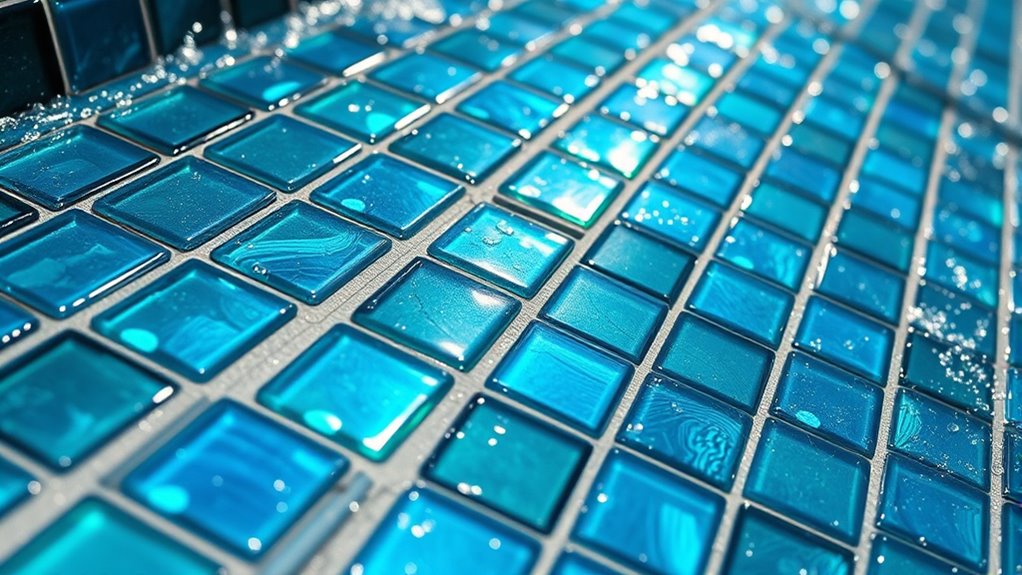
Implementing proper installation techniques is essential for guaranteeing the long-term durability of glass tiles on a spillway. Start by thoroughly cleaning the substrate to remove dust, grease, and loose debris, which ensures strong adhesion. Use a flexible, high-quality adhesive designed for outdoor and freeze-thaw conditions, applying it evenly with a notched trowel. Leave appropriate gaps between tiles to accommodate movement and expansion, reducing stress on the glass. Carefully set each tile, pressing firmly to eliminate air pockets and ensure full contact. Use spacers to maintain consistent grout lines. Finally, allow sufficient curing time before exposing the surface to water or weather. Following these steps helps prevent cracking, dislodgement, and damage caused by environmental stresses, promoting a durable, long-lasting glass tile installation. Incorporating proper joint spacing can further accommodate thermal expansion and contraction, enhancing the installation’s resilience over time.
Maintenance and Inspection Tips for Glass Tile Spillways
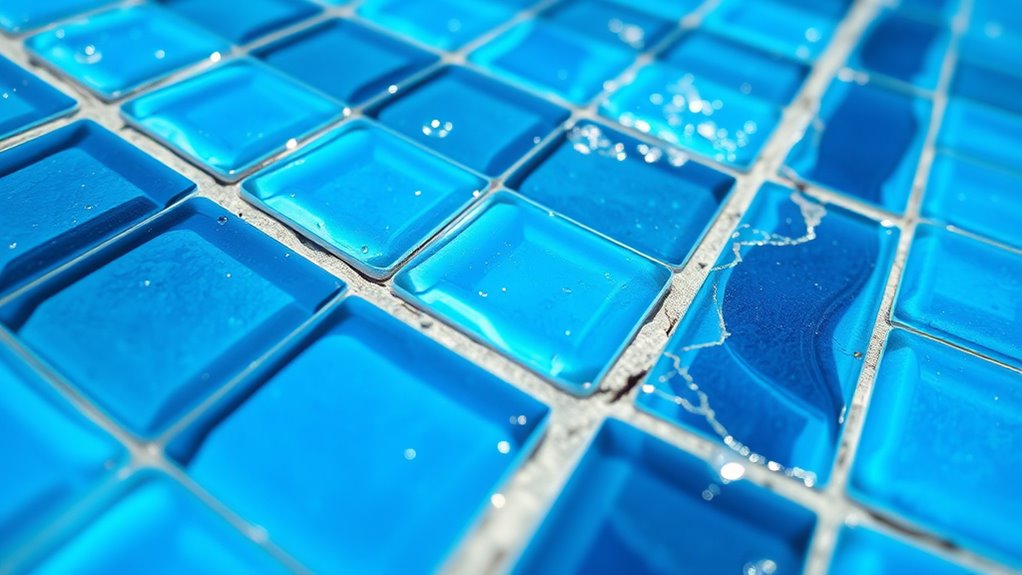
Regular maintenance and inspections are essential to keep glass tile spillways performing well over time. Check for loose or damaged tiles regularly, especially after storms or freeze-thaw cycles. Clean the surface with gentle, non-abrasive cleaners to remove dirt, algae, or mineral deposits that can compromise grout and tiles. Inspect grout joints for cracks or deterioration, and reapply or repair them as needed to prevent water infiltration. Look for signs of movement or shifting in the tiles, which could indicate underlying issues. During inspections, examine the overall condition of the spillway, paying attention to areas prone to freeze-thaw damage. Promptly address any problems to extend the life of your glass tile spillway and ensure it remains both functional and visually appealing.
Frequently Asked Questions
How Do Environmental Factors Affect Glass Tile Longevity on Spillways?
Environmental factors critically impact your glass tile’s lifespan on spillways. Freezing temperatures cause water to expand, risking cracks or dislodging tiles if not properly installed with suitable grout. UV exposure from sunlight can fade colors over time. Heavy rain or moisture can weaken grout joints, leading to movement and potential damage. To guarantee longevity, you should select weather-resistant grout, improve drainage, and regularly inspect for damage caused by these environmental elements.
What Safety Precautions Are Recommended During Installation and Maintenance?
Did you know proper installation reduces failure rates by up to 50%? During installation and maintenance, always wear protective gear like gloves and eye protection. Guarantee the spillway area is secure and clear of debris. Use appropriate tools and follow manufacturer instructions meticulously. Regularly inspect tiles for cracks or looseness, and avoid working in extreme weather conditions. These precautions keep you safe and prolong your glass tile’s lifespan.
Are There Eco-Friendly Grout Options Suitable for Spillway Applications?
Yes, you can choose eco-friendly grout options for spillway applications. Look for grout made from recycled materials or those labeled as low-VOC and biodegradable. These options reduce environmental impact and prevent toxic runoff. Make sure they are durable, waterproof, and suitable for freeze-thaw cycles to ensure longevity and safety. Always verify product certifications and consult with suppliers to select the best eco-friendly grout for your spillway project.
How Does Sunlight Exposure Impact Glass Tile Color Over Time?
Sunlight exposure causes glass tile colors to fade, crack, or change over time. You’ll notice the vibrant hues dulling, the surface developing a frosted look, and subtle color shifts that alter the original design. Prolonged direct sunlight accelerates this process, especially in outdoor spillways. To protect your tiles, consider UV-resistant coatings or shading. Being aware of these effects helps you maintain the beauty and integrity of your glass tile installation.
What Are the Cost Implications of Different Grout and Tile Choices?
Choosing high-quality glass tiles and premium grout increases your initial costs but saves you money long-term. Cheaper options may require frequent repairs or replacements, especially in outdoor spillways exposed to weather. Light-colored grout can show dirt more easily, leading to more cleaning. Investing in durable, weather-resistant materials reduces maintenance and replacement expenses, ensuring your spillway remains functional and attractive without ongoing costly repairs.
Conclusion
By choosing the right grout, allowing for movement, and ensuring freeze-thaw resistance, you can keep your glass tile spillway looking great for years. For example, a community dam installed with proper expansion joints and durable grout saw fewer cracks after harsh winters. Pay attention to installation details and schedule regular inspections. With these precautions, your spillway will remain both beautiful and functional, even in challenging weather conditions.
